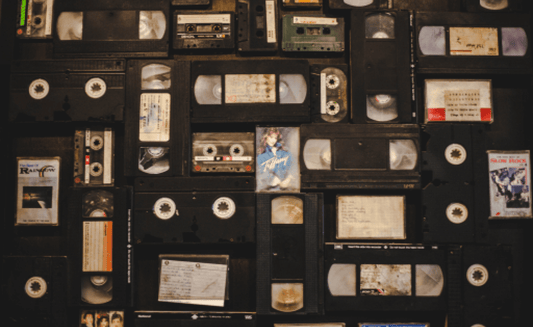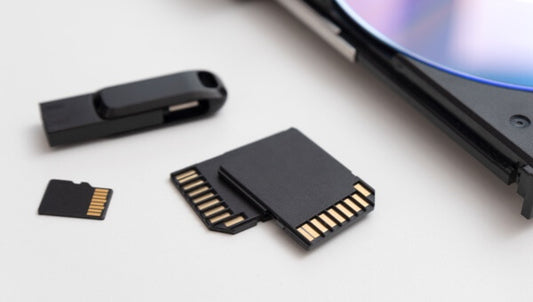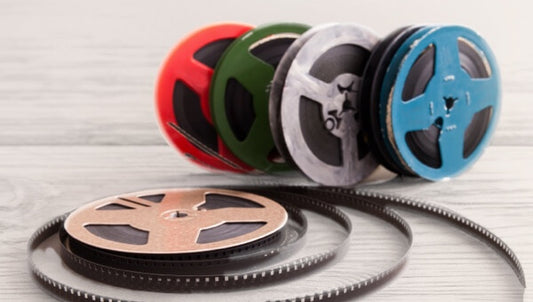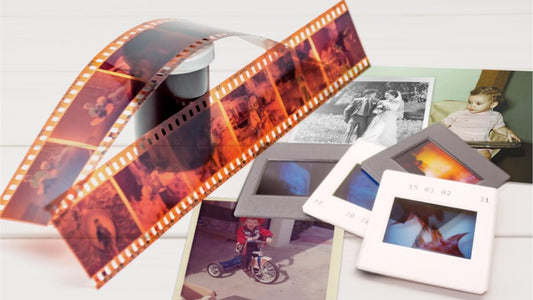While VHS tapes dominated home recording in the 1980s and 90s, S-VHS (Super VHS) offered an improved version with sharper resolution and clearer detail for preserving precious home videos. Since 1999, Capture has digitized and preserved collections including VHS, S-VHS, VHS-C, MiniDV, and Betamax, and many customers still wonder what S-VHS is, how it differs from VHS, whether it can play in a VHS player, and how it compares to digital video today. This guide explains the key differences, why S-VHS remains popular with collectors and filmmakers, and where to find S-VHS tapes and VCRs now.
Table of Contents
- What Is S-VHS?
- What Is the Difference Between VHS and S-VHS?
- Does S-VHS Have Better Sound Than VHS?
- Can a VHS Player Play S-VHS Tapes?
- Why Is S-VHS Still Popular in the Digital Age?
- Are S-VHS Tapes Worth Anything Today?
- S-VHS vs Modern Digital Formats
- Why Do Filmmakers Still Use S-VHS?
- Finding and Restoring S-VHS Equipment
- How to Build a Valuable S-VHS Collection
- The Future of S-VHS
- The Lasting Legacy of S-VHS
What Is S-VHS?
S-VHS, or Super VHS, is an upgraded version of the standard VHS tape format that offers sharper video resolution and clearer detail.
At the height of 1980s popular culture JVC, or the Victor Company of Japan, introduced the S-VHS format in Japan. In 1987, they released what is called Super VHS, or S-VHS, as an improved version of their VHS standard.
Alongside the new format came the JVC HR-S7000 S-VHS VCR, the first machine built to handle these upgraded tapes. Before long, other electronics giants like Toshiba, RCA, Sony, and Panasonic joined in by producing S-VHS camcorders, VCRs, and blank cassettes. Although S-VHS never reached the mass-market popularity of regular VHS, it became known for delivering superior picture and sound quality that appealed to enthusiasts and professionals alike.

S-VHS is a sharper, upgraded version of VHS released in 1987.
What Is the Difference Between VHS and S-VHS?
At first glance, S-VHS tapes look almost identical to VHS tapes, unlike the noticeable size difference between VHS and Betamax. The difference is inside:
- Resolution: Standard VHS offered about 240 horizontal lines, while S-VHS delivered 400 lines for a sharper, clearer image.
- Signal quality: S-VHS VCRs recorded in the 5.4 to 7.0 MHz range, compared to the lower luminance bandwidth of standard VHS machines.
- Color formats: PAL S-VHS tapes provided even stronger chrominance than the NTSC versions more common in North America.
Does S-VHS Have Better Sound Than VHS?
Both formats offered similar audio features, but S-VHS used higher carrier frequencies. This allowed for more detailed sound with less distortion or background noise. For family events like weddings or graduations, S-VHS camcorders provided noticeably better audio and video quality compared to standard VHS.
Can a VHS Player Play S-VHS Tapes?
If you’re wondering “Can I play S-VHS tapes in a regular VHS player?” the answer is no. Standard VHS decks cannot read the higher-quality signal from S-VHS recordings. To view them, you need a dedicated Super VHS VCR. Some later combo players supported both VHS and S-VHS, and a few even included built-in DVD functionality.
Why Is S-VHS Still Popular in the Digital Age?
There’s no denying the nostalgia surrounding the 1970s, 80s, and 90s - from 80s clothing, music, and home entertainment. Just like standard VHS tapes, S-VHS (Super VHS) evokes memories of growing up in that era. The difference is that S-VHS delivers the same retro experience with sharper image quality, making it feel closer to the digital video formats we’re used to today.

S-VHS remains popular for nostalgia and quality.
Are S-VHS Tapes Worth Anything Today?
Yes - unlike standard VHS, which is easy to find on eBay or Amazon Marketplace, S-VHS tapes are harder to come by and often sell for more. Their rarity, higher quality, and analog nostalgia are exactly what make them so appealing in the digital age.
S-VHS tapes have become sought-after collector’s items. Some people like to record new memories in the analog format they find nostalgic and fun to use. Others like to find S-VHS camcorders, tapes, and VCRs for sale to then sell again at a profit.
Some like to collect the rare movies that were released on S-VHS like Indiana Jones and The Last Crusade, The Terminator, or popular horror movies from the 80s.
S-VHS vs Modern Digital Formats
Compared with regular VHS, Super VHS might be superior, but when it comes to modern digital formats it falls short. The closest VHS technology ever came to digital quality was D-VHS, a digital video recording format released in 1997 by JVC, Hitachi, Matsushita, and Philips; the same year DVDs arrived in the U.S. market.
While collectors still enjoy S-VHS ET, PAL, and NTSC formats, the release of high-end DVD recorders and later HD Blu-ray discs pushed analog into decline. Just as people converted cassette tapes to CDs, many began to convert VHS to DVD, signaling the beginning of the end for all VHS formats, including Super VHS. S-VHS was officially discontinued around 2016, leaving only preowned equipment and tapes available on the secondary market.
| Feature | S-VHS | DVD |
|---|---|---|
| Year introduced | 1987 | 1997 (U.S.) |
| Recording type | Analog tape | Digital optical disc |
| Resolution | ~400 horizontal lines | 720 × 480 pixels (NTSC), 720 × 576 (PAL) |
| Audio | Hi-Fi stereo (analog) | Dolby Digital, PCM, multi-channel |
| Picture quality | Sharper than VHS, softer than DVD | Crisp digital image, stable playback |
| Media durability | Magnetic tape wear and dropout over time | Less wear in playback, but scratches possible |
| Player availability | Used market only | New and used players still available |
| Ease of digitizing | Requires capture hardware and S-VHS deck | Direct rip or capture; simpler workflows |
| Typical use today | Nostalgia, collecting, creative aesthetic | Playback of legacy libraries, archiving |
How Does S-VHS Compare to DVD and Streaming Quality?
DVD resolution is 720 × 480 pixels, far sharper than S-VHS’s analog 400-line resolution. Today, with HDMI adapters, HD streaming, and crisp mobile playback, S-VHS simply can’t compete. That being said, a vintage camcorder for S-VHS tapes does offer some charm that you might not be able to achieve with modern devices.
Why Do Filmmakers Still Use S-VHS?
If you’re looking for the highest possible video and audio quality, S-VHS isn’t the best choice. But many filmmakers and videographers continue to use it for creative reasons, including:
- Experimentation with analog formats – S-VHS lets creators splice footage, add practical effects, and create intentional gaps that digital often eliminates.
- Hands-on filmmaking – Using an old video camera provides a tactile, immersive experience compared to today’s point-and-shoot or ultra-HD devices.
- Unique retro aesthetic – The analog look of S-VHS delivers textures and imperfections that filters and editing tools struggle to replicate.
- Nostalgia and artistry – Even though the last VHS movie was released years ago, S-VHS still appeals to filmmakers, collectors, and analog media enthusiasts who value its vintage character.
Finding and Restoring S-VHS Equipment
If you’re wondering do they still make VCRs the answer is no. Production of VHS and S-VHS VCRs stopped years ago. That means you have to find preowned S-VHs tapes, camcorders, and VCRs, but luckily there are plenty of people looking to recycle VHS tapes and wondering what to do with old VHS tapes including Super VHS gear.

Filmmakers use S-VHS for its retro aesthetic.
Where Can You Buy S-VHS Tapes and Players?
- Online marketplaces: eBay, Craigslist, Etsy, and other secondhand platforms are usually the best starting point.
- Local options: Pawn shops, antique stores, flea markets, and garage sales sometimes have S-VHS VCRs or camcorders.
- Specialty forums: Sites like VideoHelp.com and vintage media groups often connect collectors who buy, sell, or trade equipment.
How Do You Restore S-VHS Equipment?
Because this equipment is decades old, it may require cleaning or minor repairs before it works properly:
- Exterior and interior cleaning: Dust, dirt, and residue can interfere with tape playback.
- Tape repair: Splice broken magnetic tape or rehouse it in a new shell if needed.
- Replacement parts: Belts, rollers, or heads may need to be swapped out — these are often available from the same sources that sell S-VHS decks.
How to Build a Valuable S-VHS Collection
You can build a valuable S-VHS collection over time, especially since major releases on Super VHS are rare and often highly sought after. Popular titles like Top Gun are considered collector’s items, and S-VHS combo players that also handle standard VHS tapes are prized as well.
If you plan on collecting, it’s important to know how long tapes last and how to care for them. Proper storage is essential to maintain quality:
- Keep tapes away from moisture and humidity
- Avoid direct sunlight and heat exposure
- Protect them from extreme temperatures
- Store tapes upright to prevent warping
Beyond storage, you should also:
- Convert VHS and S-VHS tapes to digital to preserve the content while still keeping the original copies. This ensures deterioration won’t erase your family recordings or rare Hollywood releases.
- Join VHS collector groups on Facebook, Reddit, or other forums. These communities help you share knowledge, trade tapes, and connect with other analog media enthusiasts.
By combining careful storage, digitization, and community connections, you can grow a S-VHS collection that holds both nostalgic and financial value.

Collectors prize rare S-VHS tapes and players.
The Future of S-VHS
S-VHS and other VHS formats are no longer produced, which makes them increasingly rare and valuable. Still, interest in analog video has sparked a resurgence in niche communities, where collectors trade tapes, camcorders, and VCRs.
For many, S-VHS represents more than outdated tech — it’s a connection to childhood memories, family moments, and cultural nostalgia. Owning a favorite movie on Super VHS or recording with a vintage camcorder keeps that experience alive, ensuring the format maintains its place in retro media culture.
The Lasting Legacy of S-VHS
S-VHS tapes outperformed standard VHS in nearly every way: delivering sharper video, better audio, and a more faithful way to capture memories. While they never reached VHS-level popularity, today they’ve found new life among collectors, filmmakers, and nostalgia enthusiasts. What once seemed like an obsolete format now enjoys a quiet resurgence.
If you own S-VHS tapes or other old videotape formats, now is the time to preserve them. Capture can digitize your S-VHS tapes with professional equipment and expertise, ensuring your memories last in the highest possible quality.











